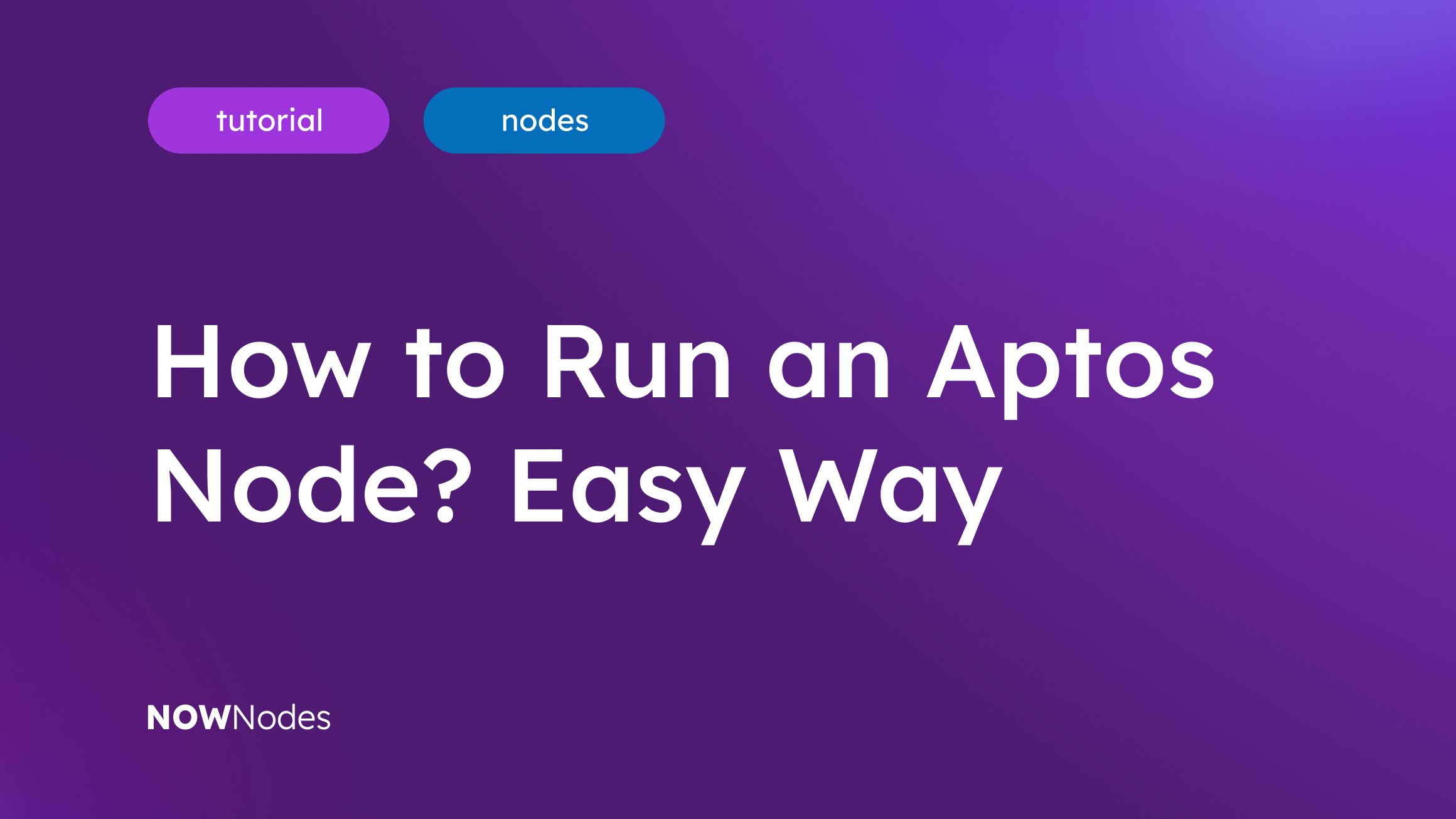This tutorial will provide you with the knowledge and tools you need to get started with Aptos node. You also will explore how to access an Aptos node with NOWNodes.
We are going to start with the easiest way to access the Aptos mainnet RPC. Explore the next paragraph and find out how to utilize Aptos mainnet RPC URL with NOWNodes.
How to Access Aptos Mainnet RPC with NOWNodes?
NOWNodes is a node-as-a-service platform that offers fast and convenient access to full RPC nodes, block explorers, and WebSocket connections through an API key. With flexible tariff plans and a wide range of offered Web3 tools, NOWNodes helps crypto businesses, developers, and enthusiasts to build and scale their dApps without any complexities.
With no-KYC platform NOWNodes’s infrastructure is designed to handle high volumes of requests, ensuring a consistent connection to the Aptos mainnet RPC. By leveraging NOWNodes to access the Aptos network RPC, you can save time and effort in setting up and managing your APT node connection, while benefiting from the node provider infrastructure, scalability, and developer-friendly features.
With just a few clicks, you can create an API key and access the Aptos mainnet RPC, and obtain the necessary connection details. Here is everything you need to do to connect to Aptos full node, step-by-step:
Step 1: Visit NOWNodes and Provide Your Email
Getting started with NOWNodes is a breeze. All you have to do is go to the NOWNodes website and provide your email address.
Step 2: Choose the Tariff Plan and Desired Blockchains
Choose a tariff plan that suits your needs. There are various options, including a free FREE plan. With the FREE plan, you can choose up to 5 blockchain networks. If you specifically need the Aptos network RPC, scroll down and click on the button next to the “Aptos” section.
Step 3: Connect to Aptos Full Node and Integrate Aptos RPC URL to Your Project
Find the dashboard page and then all you have to do is push the “GET FREE API KEY” button to access the Aptos mainnet RPC. You can now head over to the official documentation, and connect to an Aptos network RPC through the usage of one of the commands.
With NOWNodes’ APT node, a person can perform various operations and interact with the Aptos mainnet network. By utilizing Aptos mainnet RPC URL you can query Aptos mainnet data, monitor blockchain events, develop dApps, and analyze blockchain data. With access to the Aptos RPC URL, users can retrieve information, execute actions, and integrate the Aptos network RPC functionality into their applications.
NOWNodes provides seamless integration for Web3 businesses. With NOWNodes’s well-documented APIs and developer-friendly approach, integrating an Aptos network RPC into your projects becomes a straightforward task.
If you choose to build your own Aptos node, it is indeed possible to complete the process independently. However, it is important to note that it can be time-consuming and requires a certain level of technical skills to set up and maintain the node effectively. Follow the tutorial on how to run an APT node by yourself.
How to Run an Aptos Node by Yourself?
Setting up an Aptos node involves various tasks such as creating an environment, configuring files, troubleshooting errors, and investing significant time to ensure everything functions as desired. Running Aptos full node can be complex and may require extensive research and troubleshooting to overcome any challenges that arise.
To build an APT node from the source, follow these steps:
Before you begin setting up your Aptos node, there are a few requirements you need to meet:
- Supported operating systems: Linux (Ubuntu version 20.04 and 22.04), macOS Monterey and later, Windows 10, 11, and Windows Server 2022+
- CPU: 8 cores, 16 threads (Intel Xeon Skylake or newer).
- SSD: 500GB
- Memory: 32GB RAM
Now we are going to start building Aptos-core.
- To proceed with the installation process, you will need to have Git installed on your computer. Git is required to clone the
aptos-corerepository. - Once Git is installed, you can clone the Aptos repository. To do this, open a command line prompt such as Terminal on Mac/Linux or Powershell on Windows. Then, enter the following command to clone the Git repository from GitHub:
- After the repository is cloned, navigate to the newly created directory
aptos-coreby using the “cd” command:
cd aptos-core |
Before configuring an Aptos full node, you need to set up build dependencies. You can with automatic scripts or manual installation of dependencies (not recommended). For example, here are instructions for macOS:
1. Install brew package manager from https://brew.sh/.
2. Run the dev setup script: ./scripts/dev_setup.sh.
3. Update your shell environment: source ~/.cargo/env.
Linux scripts are the same, but you have to skip the first step.
Now you are in the aptos-core directory and ready to proceed with further steps for building an APT node.
First of all, make sure your current working directory is aptos-core.
To create a copy of the APT node configuration YAML template, run the following command:
cp config/src/config/test_data/public_full_node.yaml fullnode.yaml |
You will need to edit the fullnode.yaml file to ensure that your Aptos node:
- Contains the correct genesis blob provided by the Aptos mainnet network.
- Synchronizes correctly with the Aptos mainnet network.
- Stores the Aptos mainnet network database at a location of your choice on your local machine.
To download the genesis.blob and waypoint.txt files provided by the Aptos mainnet network, run the following commands:
Next, edit the fullnode.yaml file in your current working directory.
- Specify the correct path to the
waypoint.txt filethat you set by editingbase.waypoint.from_fileinfullnode.yaml. - For the
genesis_file_locationkey, ensure the full path to thegenesis.blobfile. - For the
data_dirkey in the base list, specify the directory where you want to store the mainnet database.
To run your Aptos node, run the following command:
cargo run -p aptos-node --release -- -f ./fullnode.yaml |
Now that your Aptos full node is up and running, it’s important to follow some best practices to ensure its smooth operation and longevity. Additionally, implement security measures to protect your APT node and the network. This includes setting up firewalls, enabling encryption, using secure authentication methods, and following best practices for securing your environment.
Let’s explore some additional tools and resources for Aptos network operators.
Resources and Tools for Aptos Full Node Operators
Running an Aptos full node also requires continuous learning and access to the right resources and tools. Here are some recommended resources to help you in your journey with APT node:
- Official Aptos Documentation – The official documentation provides detailed information about the Aptos network, node operation, and troubleshooting tips.
- Aptos Developer Community – Join the vibrant Aptos developer community to connect with other node operators, ask questions, and share your experiences.
- Aptos Node Monitoring Tools – Monitor the health and performance of your Aptos full node using dedicated monitoring tools.
Remember to stay updated with the latest Aptos network releases, network updates, and security advisories. Regularly check the official Aptos channels and community platforms to stay informed about any important announcements or changes that may affect your Aptos full node operation.
Conclusion
While building your own APT node can provide you with complete control and customization, it is important to consider the level of commitment, time, and expertise required to undertake this endeavor.
Alternatively, utilizing services like NOWNodes can simplify the process and provide a more streamlined and convenient solution for accessing the Aptos mainnet RPC. Whether you are building decentralized applications (dApps), or simply trying to access Aptos RPC URL for your Web3 needs, NOWNodes simplifies the process, saving you valuable time and effort. Additionally, the NOWNodes team is available to answer any questions or provide guidance whenever you need assistance with your connection to the APT mainnet RPC.
Don’t miss out on the latest articles and guides on Aptos mainnet network! We value your feedback, so feel free to ask questions and connect to our Telegram community with Support 24/7.
Key Points:
- You can easily access an Aptos mainnet RPC with NOWNodes service through an API key for interacting with the Aptos mainnet and developing your dApps.
- Running an Aptos Node by yourself is possible, but it requires technical knowledge and time commitment. Here are the general steps involved:
- Meet the APT node hardware requirements.
- Build aptos-core, set up build dependencies and Aptos full node by installing Git to clone the aptos-core repository. Edit the fullnode.yaml file to configure the Aptos node with the correct settings.
- Download the required files (genesis.blob and waypoint.txt) and specify the correct paths in the fullnode.yaml file for waypoint.txt and genesis.blob. Specify the directory to store the database.
- Run the node.



